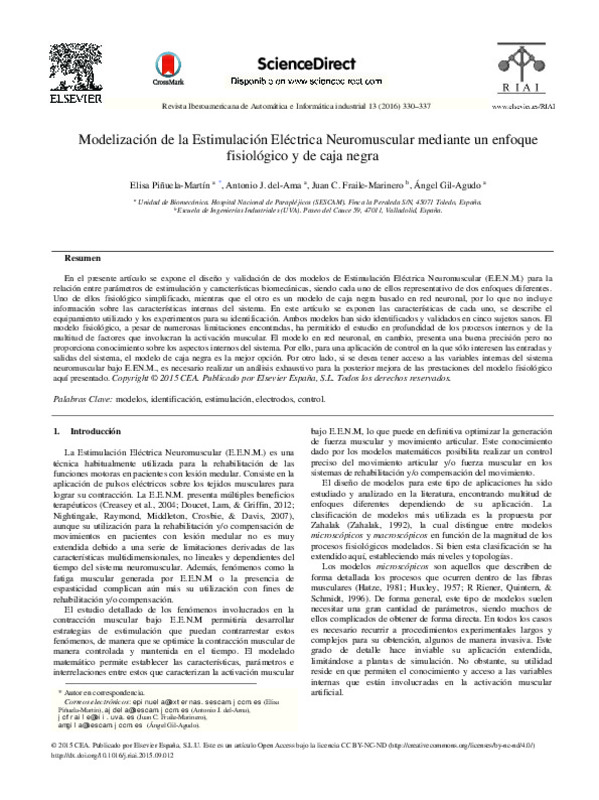Bai, E., Member, S., & Fu, M. (2002). A Blind Approach to Hammerstein Model Identification, 50(7), 1610-1619.
Creasey, G. H., Ho, C. H., Triolo, R. J., Gater, D. R., DiMarco, A. F., Bogie, K. M., & Keith, M. W. (2004). Clinical applications of electrical stimulation after spinal cord injury. The Journal of Spinal Cord Medicine, 27(4), 365-75. Retrieved from http://www.ncbi.nlm.nih.gov/pubmed/15484667
De N. Donaldson, N., Gollee, H., Hunt, K. J., Jarvis, J. C., & Kwende, M. K. N. (1995). A radial basis function model of muscle stimulated with irregular inter-pulse intervals. Medical Engineering & Physics, 17(6), 431-441. Retrieved from http://www.sciencedirect.com/science/article/pii/135045339400013Y
[+]
Bai, E., Member, S., & Fu, M. (2002). A Blind Approach to Hammerstein Model Identification, 50(7), 1610-1619.
Creasey, G. H., Ho, C. H., Triolo, R. J., Gater, D. R., DiMarco, A. F., Bogie, K. M., & Keith, M. W. (2004). Clinical applications of electrical stimulation after spinal cord injury. The Journal of Spinal Cord Medicine, 27(4), 365-75. Retrieved from http://www.ncbi.nlm.nih.gov/pubmed/15484667
De N. Donaldson, N., Gollee, H., Hunt, K. J., Jarvis, J. C., & Kwende, M. K. N. (1995). A radial basis function model of muscle stimulated with irregular inter-pulse intervals. Medical Engineering & Physics, 17(6), 431-441. Retrieved from http://www.sciencedirect.com/science/article/pii/135045339400013Y
Del-Ama, A. (2013). A comparison of customized strategies to manage muscle fatigue in isometric artificially elicited muscle contractions for incomplete SCI subjects. Journal of Automatic …, 21(1), 19-25. doi:10.2298/JAC1301019A
Doucet, B. M., Lam, A., & Griffin, L. (2012). Neuromuscular electrical stimulation for skeletal muscle function. The Yale Journal of Biology and Medicine, 85(2), 201-15. Retrieved from http://www.pubmedcentral.nih.gov/articlerender.fcgi?artid=3375668&tool =pmcentrez&rendertype=abstract
Durfee, W. K., & MacLean, K. E. (1989). Methods for estimating isometric recruitment curves of electrically stimulated muscle. IEEE Transactions on Bio-Medical Engineering, 36(7), 654-67. doi:10.1109/10.32097
Ferrarin, M., Palazzo, F., Riener, R., & Quintern, J. (2001). Model-based control of FES-induced single joint movements. IEEE Transactions on 1HXUDO 6\VWHPV DQG 5HKDELOLWDWLRQ (QJLQHHULQJࣟ $ 3XEOLFDWLRQ RI WKH IEEE Engineering in Medicine and Biology Society, 9(3), 245-57. doi:10.1109/7333.948452
Ferrarin, M., & Pedotti, a. (2000). The relationship between electrical stimulus and joint torque: a dynamic model. IEEE Transactions on Rehabilitation (QJLQHHULQJࣟ $ 3XEOLFDWLRQ RI WKH ,((( (QJLQHHULQJ LQ 0HGLFLQH DQG Biology Society, 8(3), 342-52. Retrieved from http://www.ncbi.nlm.nih.gov/pubmed/11001514
Franken, H. M., Veltink, P. H., Baardman, G., Redmeyer, R. a, & Boom, H. B. (1995). Cycle-to-cycle control of swing phase of paraplegic gait induced by surface electrical stimulation. Medical & Biological Engineering & Computing, 33(3 Spec No), 440-51. Retrieved from http://www.ncbi.nlm.nih.gov/pubmed/7666692
Franken, H. M., Veltink, P. H., Tijsmans, R., Member, S., Boom, H. B. K., & Member, A. (1993). Identification of Passive Knee Joint and Shank Dynamics in Paraplegics Using Quadriceps Stimulation, I(3).
Gollee, H. (1998). A non-linear approach to modelling and control of electrically stimulated skeletal muscle. Retrieved from http://theses.gla.ac.uk/2110/Hatwell, M. S., Oderkerk, B. J., Sacher, C. A., & Inbar, G. F. (1991). The development of a model reference adaptive controller to control the knee joint of paraplegics. IEEE Transactions on Automatic Control, 36(6), 683-691. doi:10.1109/9.86942
Hatze, H. (1981). A comprehensive model for human motion simulation and its application to the take-off phase of the long jump. Journal of Biomechanics, 14(3), 135-142. Retrieved from http://www.sciencedirect.com/science/article/pii/0021929081900191 Hill, a. V. (1938). The Heat of Shortening and the Dynamic Constants of Muscle. Proceedings of the Royal Society B: Biological Sciences, 126(843), 136-195. doi:10.1098/rspb.1938.0050
Hunt, K. J., Munih, M., Donaldson, N. N., & Barr, F. M. (1998). Investigation of the Hammerstein hypothesis in the modeling of electrically stimulated muscle. IEEE Transactions on Bio-Medical Engineering, 45(8), 998-1009. doi:10.1109/10.704868
Huxley, A. (1957). Muscle structure and theories of contraction. Prog. Biophys. Biophys. Chem, 7, 255-318. Retrieved from http://ci.nii.ac.jp/naid/10005175870/en/
Mansour, J. M., & Audu, M. L. (1986). The passive elastic moment at the knee and its influence on human gait. Journal of Biomechanics, 19, 369- 373. doi:10.1016/0021-9290(86)90013-8
Nightingale, E. J., Raymond, J., Middleton, J. W., Crosbie, J., & Davis, G. M. (2007). Benefits of FES gait in a spinal cord injured population. Spinal Cord, 45(10), 646-57. doi:10.1038/sj.sc.3102101
Perumal, R., Wexler, A. S., Kesar, T. M., Jancosko, A., Laufer, Y., & Bindermacleod, S. A. (2010). A phenomenological model that predicts forces generated when electrical stimulation is superimposed on submaximal volitional contractions, 1595-1604. doi:10.1152/japplphysiol.01231.2009.
Previdi, F. (2002). Identification of black-box nonlinear models for lower limb movement control using functional electrical stimulation. Control Engineering Practice, 10(1), 91-99. Retrieved from http://www.sciencedirect.com/science/article/pii/S0967066101001289
Riener, R., Bioingegneria, C., Projuventute, F., Gnocchi, D., Milano, P., & Capecelatro, V. (1999). Model-based development of neuroprostheses for paraplegic patients. Riener, R., Quintern, J., & Schmidt, G. (1996). Biomechanical model of the human knee evaluated by neuromuscular stimulation. Journal of Biomechanics, 29, 1157-1167. Retrieved from http://www.ncbi.nlm.nih.gov/pubmed/8872272
Schauer, T., & Hunt, K. J. (2000). Linear controller design for the single limb movement of paraplegics. In Proceedings of IFAC Symposium on Modelling and Control in Biomedical Systems (MCBS) 2000 (pp. 7-12). Winter, D. (2009). Biomechanics and motor control of human movement. Retrieved from http://books.google.com/books?hl=en&lr=&id=_bFHL08IWfwC&oi=fnd &pg=PA14&dq=Biomechanics+and+Motor+Control+of+Human+Movem ent&ots=Jkoycr88W3&sig=7j08867HDz0lSQhregc3MPeD60Q
Winters, J. M. (1995). An improved muscle-reflex actuator for use in largescale neuromusculoskeletal models. Annals of Biomedical Engineering, 23(4), 359-374. doi:10.1007/BF02584437
Zahalak, G. I. (1992). An overview of muscle modeling. Neural Prostheses: Replacing Motor Function After Disease or Disability. New York: Oxford Univ. Press.
Zajac, F. E. (1989). Muscle and tendon: properties, models, scaling, and application to biomechanics and motor control. Critical Reviews in Biomedical Engineering, 17(4), 359-411. Retrieved from http://europepmc.org/abstract/MED/2676342/reload=0
Zajac, F. E., Neptune, R. R., & Kautz, S. A. (2003). Biomechanics and muscle coordination of human walking: part II: lessons from dynamical simulations and clinical implications. Gait & Posture, 17, 1-17. Retrieved from http://www.ncbi.nlm.nih.gov/pubmed/12535721
[-]








